Organisational Change: A Case Study of Australia Post Reforms
VerifiedAdded on 2023/06/04
|12
|3144
|401
Case Study
AI Summary
This case study report analyzes the organizational changes and reforms undertaken by Australia Post, including the introduction of smart Point of Sale (POS), changes to the remuneration structure, and reforms to letter services. The report examines the factors driving these changes, such as technological advancements, the need for diversity and convenience, and financial pressures. It also highlights the people development strategies used to manage change and mitigate resistance, such as effective communication, embracing optimism, and supporting staff skill development. Furthermore, the report outlines Australia Post's future strategies, including a focus on diversity and inclusion, working with an extended workforce, and cultivating a sustainable safety culture. The analysis concludes with lessons learned regarding the impact of internal and external forces on organizational change, and the importance of leadership skills and effective strategies in managing these changes.
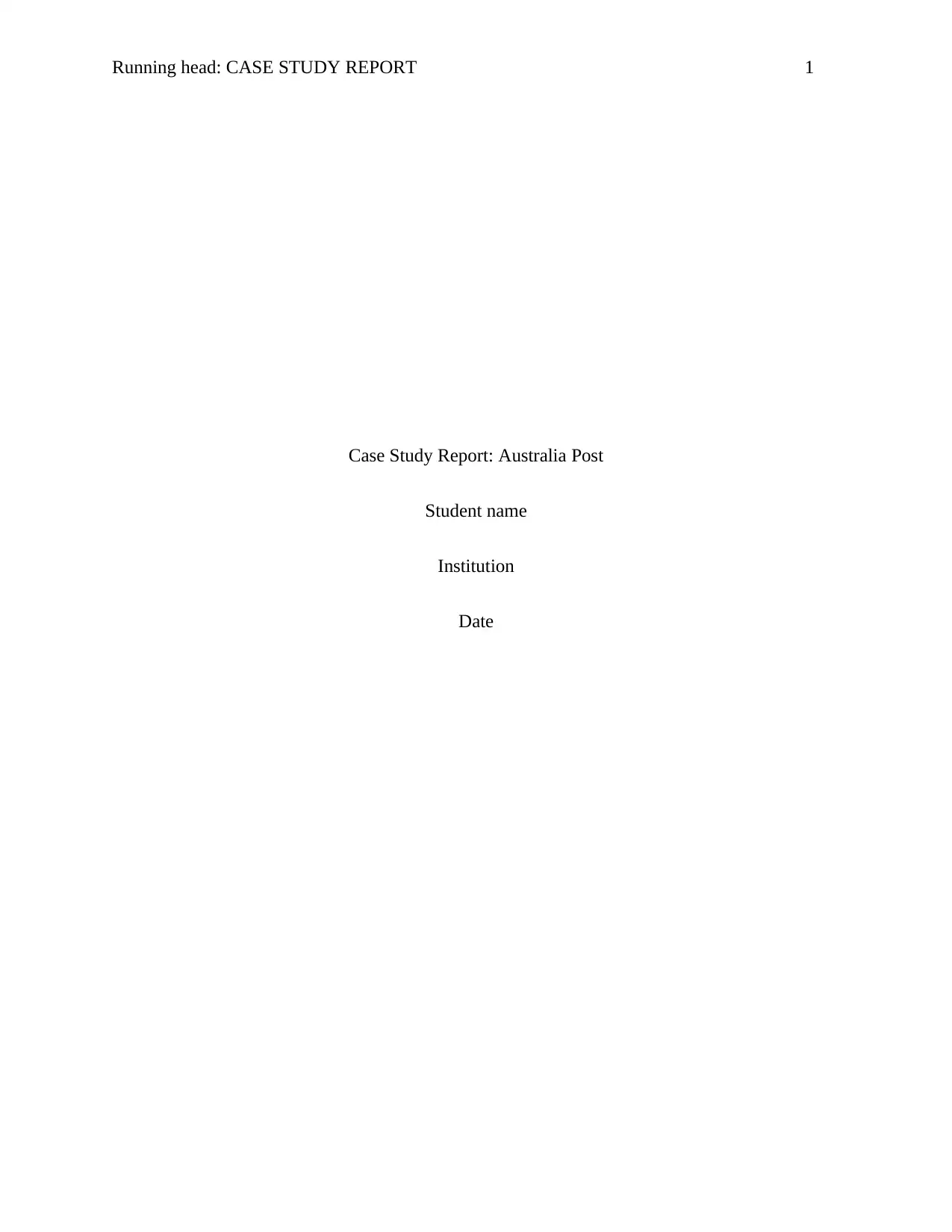
Running head: CASE STUDY REPORT 1
Case Study Report: Australia Post
Student name
Institution
Date
Case Study Report: Australia Post
Student name
Institution
Date
Paraphrase This Document
Need a fresh take? Get an instant paraphrase of this document with our AI Paraphraser
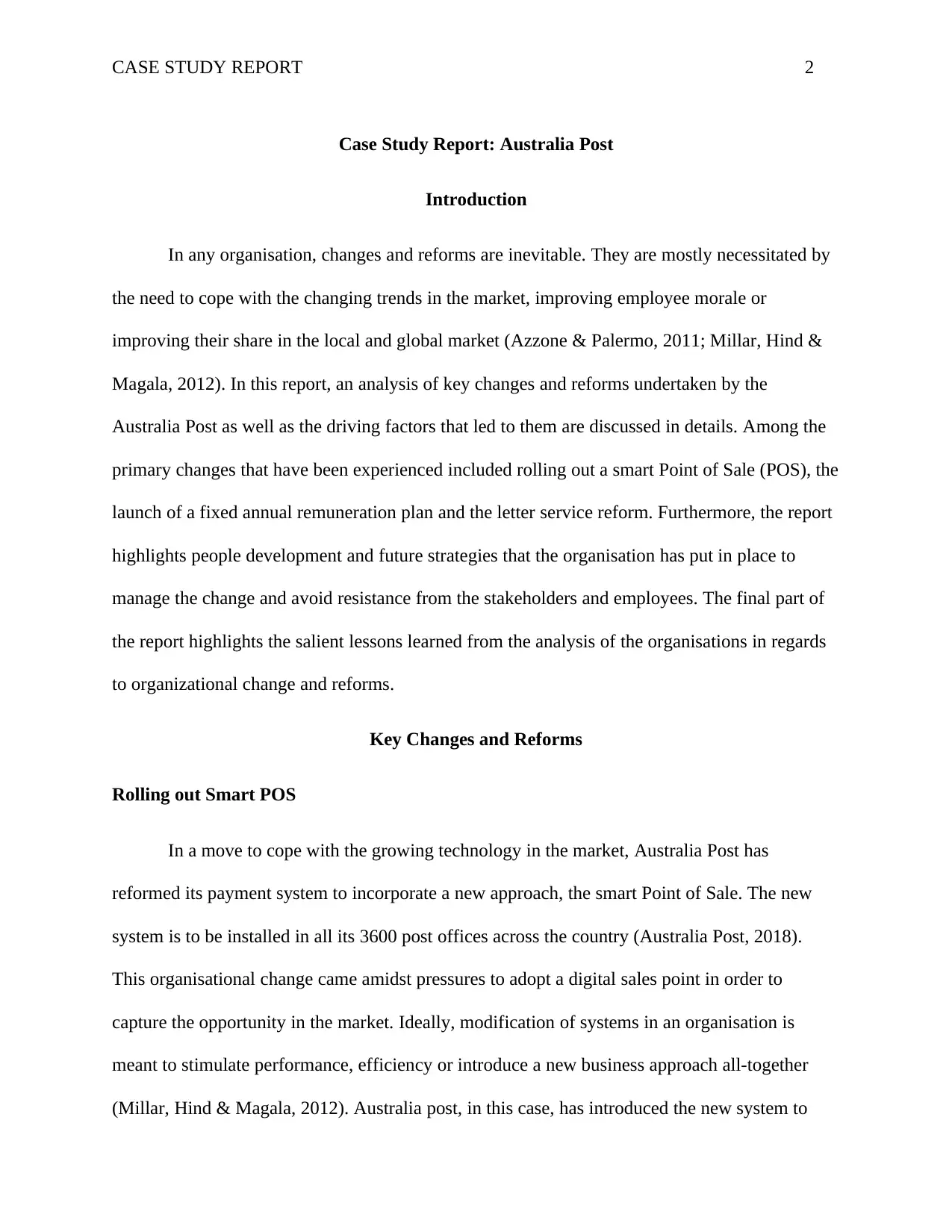
CASE STUDY REPORT 2
Case Study Report: Australia Post
Introduction
In any organisation, changes and reforms are inevitable. They are mostly necessitated by
the need to cope with the changing trends in the market, improving employee morale or
improving their share in the local and global market (Azzone & Palermo, 2011; Millar, Hind &
Magala, 2012). In this report, an analysis of key changes and reforms undertaken by the
Australia Post as well as the driving factors that led to them are discussed in details. Among the
primary changes that have been experienced included rolling out a smart Point of Sale (POS), the
launch of a fixed annual remuneration plan and the letter service reform. Furthermore, the report
highlights people development and future strategies that the organisation has put in place to
manage the change and avoid resistance from the stakeholders and employees. The final part of
the report highlights the salient lessons learned from the analysis of the organisations in regards
to organizational change and reforms.
Key Changes and Reforms
Rolling out Smart POS
In a move to cope with the growing technology in the market, Australia Post has
reformed its payment system to incorporate a new approach, the smart Point of Sale. The new
system is to be installed in all its 3600 post offices across the country (Australia Post, 2018).
This organisational change came amidst pressures to adopt a digital sales point in order to
capture the opportunity in the market. Ideally, modification of systems in an organisation is
meant to stimulate performance, efficiency or introduce a new business approach all-together
(Millar, Hind & Magala, 2012). Australia post, in this case, has introduced the new system to
Case Study Report: Australia Post
Introduction
In any organisation, changes and reforms are inevitable. They are mostly necessitated by
the need to cope with the changing trends in the market, improving employee morale or
improving their share in the local and global market (Azzone & Palermo, 2011; Millar, Hind &
Magala, 2012). In this report, an analysis of key changes and reforms undertaken by the
Australia Post as well as the driving factors that led to them are discussed in details. Among the
primary changes that have been experienced included rolling out a smart Point of Sale (POS), the
launch of a fixed annual remuneration plan and the letter service reform. Furthermore, the report
highlights people development and future strategies that the organisation has put in place to
manage the change and avoid resistance from the stakeholders and employees. The final part of
the report highlights the salient lessons learned from the analysis of the organisations in regards
to organizational change and reforms.
Key Changes and Reforms
Rolling out Smart POS
In a move to cope with the growing technology in the market, Australia Post has
reformed its payment system to incorporate a new approach, the smart Point of Sale. The new
system is to be installed in all its 3600 post offices across the country (Australia Post, 2018).
This organisational change came amidst pressures to adopt a digital sales point in order to
capture the opportunity in the market. Ideally, modification of systems in an organisation is
meant to stimulate performance, efficiency or introduce a new business approach all-together
(Millar, Hind & Magala, 2012). Australia post, in this case, has introduced the new system to
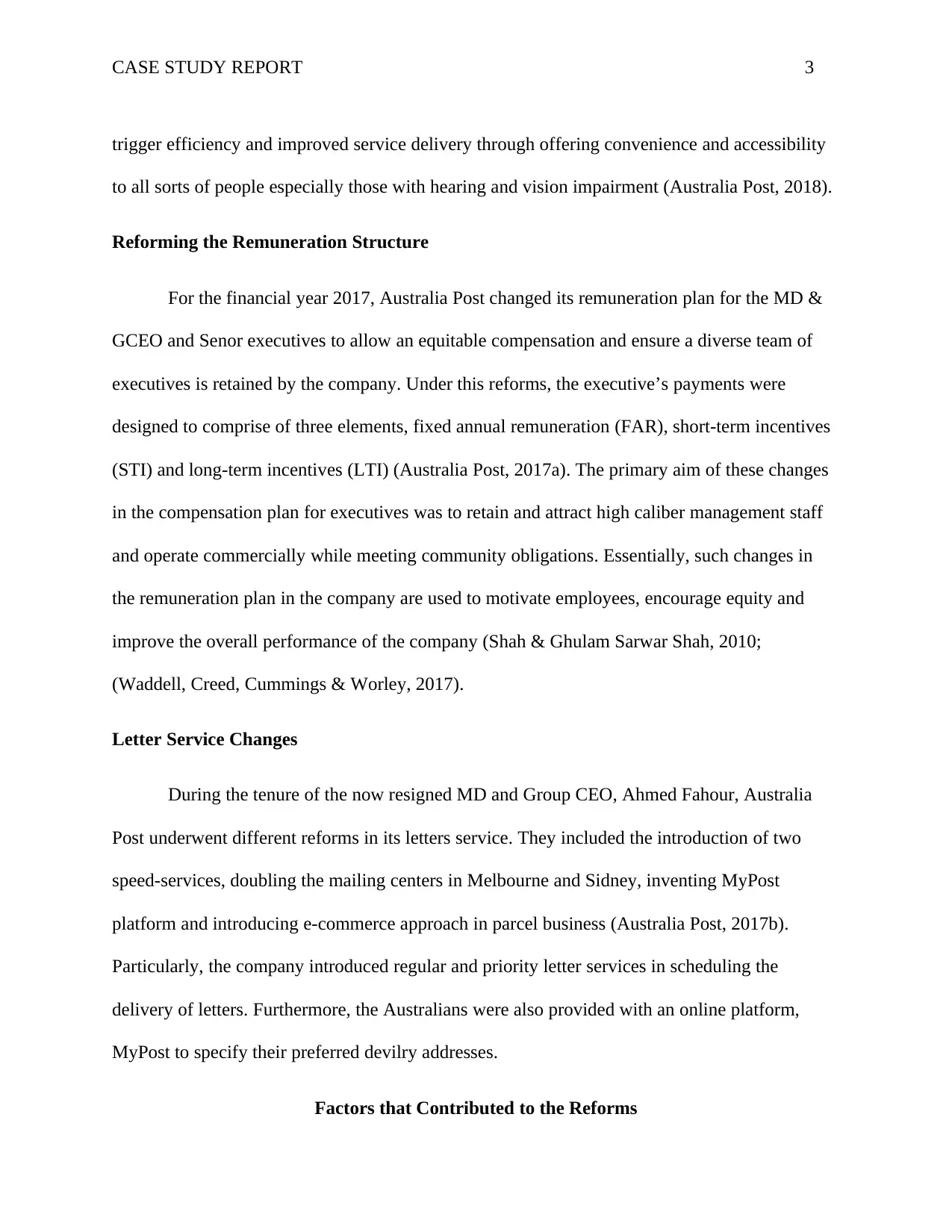
CASE STUDY REPORT 3
trigger efficiency and improved service delivery through offering convenience and accessibility
to all sorts of people especially those with hearing and vision impairment (Australia Post, 2018).
Reforming the Remuneration Structure
For the financial year 2017, Australia Post changed its remuneration plan for the MD &
GCEO and Senor executives to allow an equitable compensation and ensure a diverse team of
executives is retained by the company. Under this reforms, the executive’s payments were
designed to comprise of three elements, fixed annual remuneration (FAR), short-term incentives
(STI) and long-term incentives (LTI) (Australia Post, 2017a). The primary aim of these changes
in the compensation plan for executives was to retain and attract high caliber management staff
and operate commercially while meeting community obligations. Essentially, such changes in
the remuneration plan in the company are used to motivate employees, encourage equity and
improve the overall performance of the company (Shah & Ghulam Sarwar Shah, 2010;
(Waddell, Creed, Cummings & Worley, 2017).
Letter Service Changes
During the tenure of the now resigned MD and Group CEO, Ahmed Fahour, Australia
Post underwent different reforms in its letters service. They included the introduction of two
speed-services, doubling the mailing centers in Melbourne and Sidney, inventing MyPost
platform and introducing e-commerce approach in parcel business (Australia Post, 2017b).
Particularly, the company introduced regular and priority letter services in scheduling the
delivery of letters. Furthermore, the Australians were also provided with an online platform,
MyPost to specify their preferred devilry addresses.
Factors that Contributed to the Reforms
trigger efficiency and improved service delivery through offering convenience and accessibility
to all sorts of people especially those with hearing and vision impairment (Australia Post, 2018).
Reforming the Remuneration Structure
For the financial year 2017, Australia Post changed its remuneration plan for the MD &
GCEO and Senor executives to allow an equitable compensation and ensure a diverse team of
executives is retained by the company. Under this reforms, the executive’s payments were
designed to comprise of three elements, fixed annual remuneration (FAR), short-term incentives
(STI) and long-term incentives (LTI) (Australia Post, 2017a). The primary aim of these changes
in the compensation plan for executives was to retain and attract high caliber management staff
and operate commercially while meeting community obligations. Essentially, such changes in
the remuneration plan in the company are used to motivate employees, encourage equity and
improve the overall performance of the company (Shah & Ghulam Sarwar Shah, 2010;
(Waddell, Creed, Cummings & Worley, 2017).
Letter Service Changes
During the tenure of the now resigned MD and Group CEO, Ahmed Fahour, Australia
Post underwent different reforms in its letters service. They included the introduction of two
speed-services, doubling the mailing centers in Melbourne and Sidney, inventing MyPost
platform and introducing e-commerce approach in parcel business (Australia Post, 2017b).
Particularly, the company introduced regular and priority letter services in scheduling the
delivery of letters. Furthermore, the Australians were also provided with an online platform,
MyPost to specify their preferred devilry addresses.
Factors that Contributed to the Reforms
⊘ This is a preview!⊘
Do you want full access?
Subscribe today to unlock all pages.

Trusted by 1+ million students worldwide
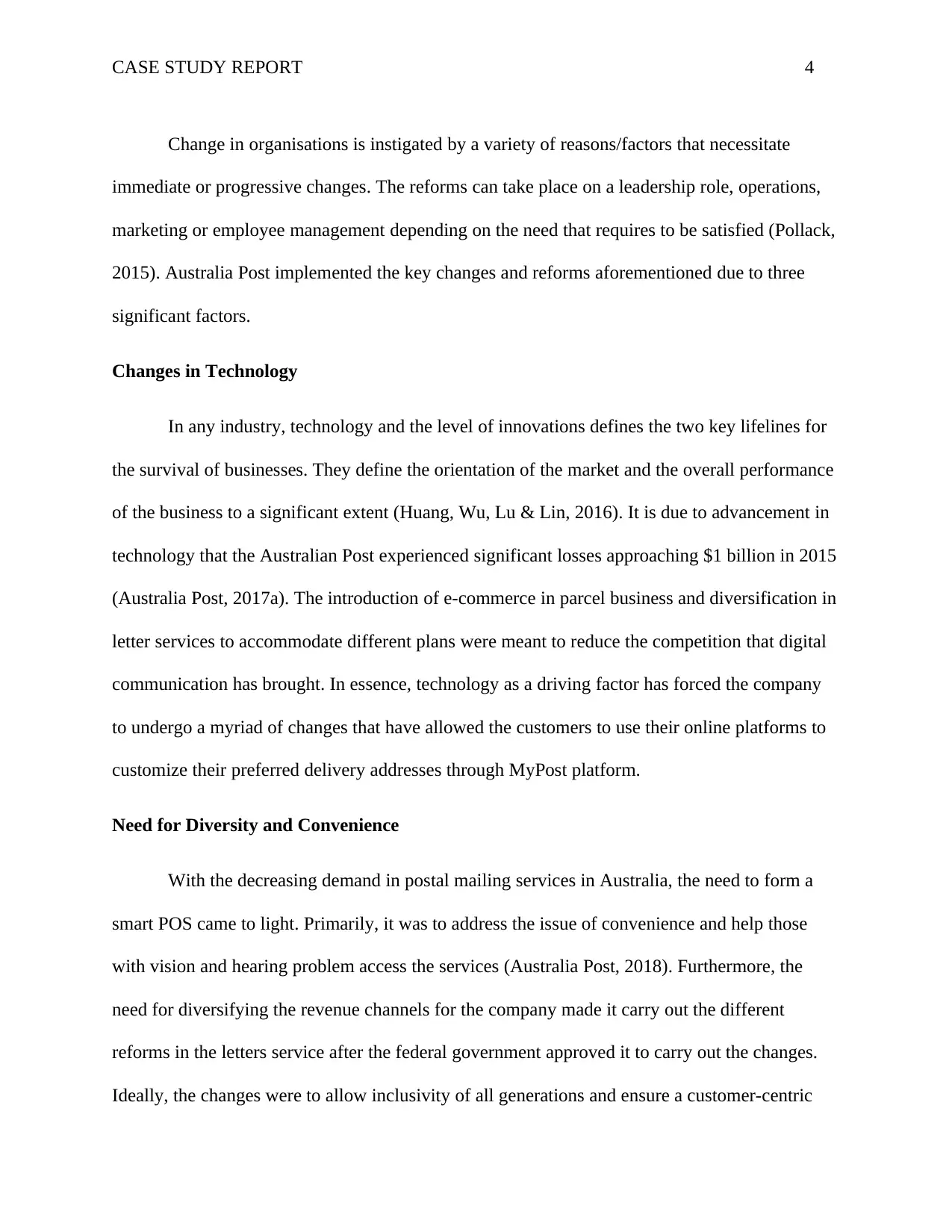
CASE STUDY REPORT 4
Change in organisations is instigated by a variety of reasons/factors that necessitate
immediate or progressive changes. The reforms can take place on a leadership role, operations,
marketing or employee management depending on the need that requires to be satisfied (Pollack,
2015). Australia Post implemented the key changes and reforms aforementioned due to three
significant factors.
Changes in Technology
In any industry, technology and the level of innovations defines the two key lifelines for
the survival of businesses. They define the orientation of the market and the overall performance
of the business to a significant extent (Huang, Wu, Lu & Lin, 2016). It is due to advancement in
technology that the Australian Post experienced significant losses approaching $1 billion in 2015
(Australia Post, 2017a). The introduction of e-commerce in parcel business and diversification in
letter services to accommodate different plans were meant to reduce the competition that digital
communication has brought. In essence, technology as a driving factor has forced the company
to undergo a myriad of changes that have allowed the customers to use their online platforms to
customize their preferred delivery addresses through MyPost platform.
Need for Diversity and Convenience
With the decreasing demand in postal mailing services in Australia, the need to form a
smart POS came to light. Primarily, it was to address the issue of convenience and help those
with vision and hearing problem access the services (Australia Post, 2018). Furthermore, the
need for diversifying the revenue channels for the company made it carry out the different
reforms in the letters service after the federal government approved it to carry out the changes.
Ideally, the changes were to allow inclusivity of all generations and ensure a customer-centric
Change in organisations is instigated by a variety of reasons/factors that necessitate
immediate or progressive changes. The reforms can take place on a leadership role, operations,
marketing or employee management depending on the need that requires to be satisfied (Pollack,
2015). Australia Post implemented the key changes and reforms aforementioned due to three
significant factors.
Changes in Technology
In any industry, technology and the level of innovations defines the two key lifelines for
the survival of businesses. They define the orientation of the market and the overall performance
of the business to a significant extent (Huang, Wu, Lu & Lin, 2016). It is due to advancement in
technology that the Australian Post experienced significant losses approaching $1 billion in 2015
(Australia Post, 2017a). The introduction of e-commerce in parcel business and diversification in
letter services to accommodate different plans were meant to reduce the competition that digital
communication has brought. In essence, technology as a driving factor has forced the company
to undergo a myriad of changes that have allowed the customers to use their online platforms to
customize their preferred delivery addresses through MyPost platform.
Need for Diversity and Convenience
With the decreasing demand in postal mailing services in Australia, the need to form a
smart POS came to light. Primarily, it was to address the issue of convenience and help those
with vision and hearing problem access the services (Australia Post, 2018). Furthermore, the
need for diversifying the revenue channels for the company made it carry out the different
reforms in the letters service after the federal government approved it to carry out the changes.
Ideally, the changes were to allow inclusivity of all generations and ensure a customer-centric
Paraphrase This Document
Need a fresh take? Get an instant paraphrase of this document with our AI Paraphraser

CASE STUDY REPORT 5
approach is maintained while undertaking the business. As it is in any other business customer-
oriented changes are beneficial to the performance of an organisation as it increases customer
retention and loyalty (Smith, 2011).
Increased Losses and Danger of Losing Senior Executives
The burden of losses may trigger anxiety among its employees owing to the implications
that it has on the ability of an organisation to fully exercise its financial operations (Cloutier,
Felusiak, Hill & Pemberton-Jones, 2015). As a result, employee turnover may be experienced.
Australian Post was faced with this threats prior to implementation of the various changes in its
operations and remuneration of the senior management. Additionally, an increasing loss from
mail services was among the reasons they diversified their service delivery to include e-
commerce and different categories of letter delivery schedules.
People Development Strategies to Overcome Resistance to Change
It a normal when stakeholder or employees resist changes implemented in an organisation
(Millar, Hind & Magala, 2012). However, before and during the reforms, strategies have to be in
place to reduce any potential fallout between the management, staff and other stakeholders. In
the same context, Australia Post managed to successfully implement their changes with the help
of various people development strategies in place.
Effective communication and inclusion
For every change made within the company, stakeholders and staff were involved in
making the decisions. For instance, the Australia Post Enterprise Agreement was arrived at after
negotiations with all parties involved (Australia Post, 2017a). This strategy was meant to protect
approach is maintained while undertaking the business. As it is in any other business customer-
oriented changes are beneficial to the performance of an organisation as it increases customer
retention and loyalty (Smith, 2011).
Increased Losses and Danger of Losing Senior Executives
The burden of losses may trigger anxiety among its employees owing to the implications
that it has on the ability of an organisation to fully exercise its financial operations (Cloutier,
Felusiak, Hill & Pemberton-Jones, 2015). As a result, employee turnover may be experienced.
Australian Post was faced with this threats prior to implementation of the various changes in its
operations and remuneration of the senior management. Additionally, an increasing loss from
mail services was among the reasons they diversified their service delivery to include e-
commerce and different categories of letter delivery schedules.
People Development Strategies to Overcome Resistance to Change
It a normal when stakeholder or employees resist changes implemented in an organisation
(Millar, Hind & Magala, 2012). However, before and during the reforms, strategies have to be in
place to reduce any potential fallout between the management, staff and other stakeholders. In
the same context, Australia Post managed to successfully implement their changes with the help
of various people development strategies in place.
Effective communication and inclusion
For every change made within the company, stakeholders and staff were involved in
making the decisions. For instance, the Australia Post Enterprise Agreement was arrived at after
negotiations with all parties involved (Australia Post, 2017a). This strategy was meant to protect

CASE STUDY REPORT 6
the existing benefits as well as ensuring the staff of job security despite the changes being done.
According to the 2017 annual report by Australia Post (2017a), employee engagement increased
by 4% during and after the changes as a result of the communication and inclusion in decision
making. Essentially, employee turnover and resistance to change is minimal when there is
representation when decisions on reforms are done within an organisation (Gialuisi & Coetzer,
2013).
Embracing optimism
It is believed that the task of implementing reforms in an organisation can be daunting
and needs positivity for it to be fully adopted and accepted by others (Grant, 2013). The former
managing director and CEO of Australia Post, Ahmed Fahour embraced positivity in changes
made to transform the company from its declining revenues. The zeal and optimism embraced by
the leader were influential to the stakeholders and senior executives, thus making them less
resistant to the changes in operations of the company. In the long run, the optimism paid off
after meeting zero resistance to the changes making the positivity and zeal of Ahmed Fahour
worth the remuneration he was getting (Price, 2017).
Supporting and developing staff skills
As the Australia Post shifts its focus from being predominantly letter delivery business,
employees are being offered an opportunity to advance their careers the Post People Program
(Australia Post, 2017a). The program was implemented as a strategy to allow the staff to
diversify their skills and fit the new roles created by the changes made. As a result, job security
was ensured making it easier for them to accept the changes. Conventionally, providing
stakeholders and employees a zero effect on their benefits and job security makes them less
the existing benefits as well as ensuring the staff of job security despite the changes being done.
According to the 2017 annual report by Australia Post (2017a), employee engagement increased
by 4% during and after the changes as a result of the communication and inclusion in decision
making. Essentially, employee turnover and resistance to change is minimal when there is
representation when decisions on reforms are done within an organisation (Gialuisi & Coetzer,
2013).
Embracing optimism
It is believed that the task of implementing reforms in an organisation can be daunting
and needs positivity for it to be fully adopted and accepted by others (Grant, 2013). The former
managing director and CEO of Australia Post, Ahmed Fahour embraced positivity in changes
made to transform the company from its declining revenues. The zeal and optimism embraced by
the leader were influential to the stakeholders and senior executives, thus making them less
resistant to the changes in operations of the company. In the long run, the optimism paid off
after meeting zero resistance to the changes making the positivity and zeal of Ahmed Fahour
worth the remuneration he was getting (Price, 2017).
Supporting and developing staff skills
As the Australia Post shifts its focus from being predominantly letter delivery business,
employees are being offered an opportunity to advance their careers the Post People Program
(Australia Post, 2017a). The program was implemented as a strategy to allow the staff to
diversify their skills and fit the new roles created by the changes made. As a result, job security
was ensured making it easier for them to accept the changes. Conventionally, providing
stakeholders and employees a zero effect on their benefits and job security makes them less
⊘ This is a preview!⊘
Do you want full access?
Subscribe today to unlock all pages.

Trusted by 1+ million students worldwide
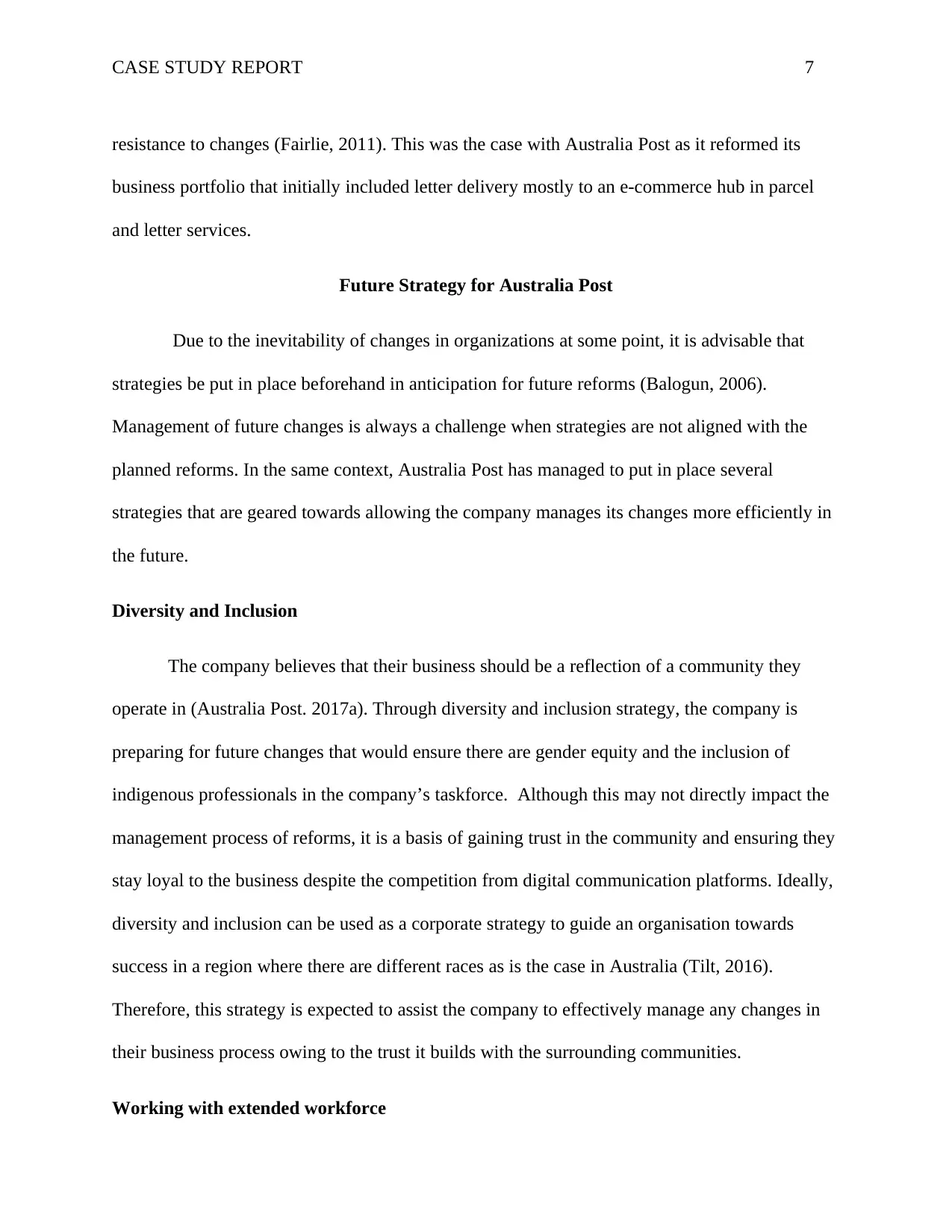
CASE STUDY REPORT 7
resistance to changes (Fairlie, 2011). This was the case with Australia Post as it reformed its
business portfolio that initially included letter delivery mostly to an e-commerce hub in parcel
and letter services.
Future Strategy for Australia Post
Due to the inevitability of changes in organizations at some point, it is advisable that
strategies be put in place beforehand in anticipation for future reforms (Balogun, 2006).
Management of future changes is always a challenge when strategies are not aligned with the
planned reforms. In the same context, Australia Post has managed to put in place several
strategies that are geared towards allowing the company manages its changes more efficiently in
the future.
Diversity and Inclusion
The company believes that their business should be a reflection of a community they
operate in (Australia Post. 2017a). Through diversity and inclusion strategy, the company is
preparing for future changes that would ensure there are gender equity and the inclusion of
indigenous professionals in the company’s taskforce. Although this may not directly impact the
management process of reforms, it is a basis of gaining trust in the community and ensuring they
stay loyal to the business despite the competition from digital communication platforms. Ideally,
diversity and inclusion can be used as a corporate strategy to guide an organisation towards
success in a region where there are different races as is the case in Australia (Tilt, 2016).
Therefore, this strategy is expected to assist the company to effectively manage any changes in
their business process owing to the trust it builds with the surrounding communities.
Working with extended workforce
resistance to changes (Fairlie, 2011). This was the case with Australia Post as it reformed its
business portfolio that initially included letter delivery mostly to an e-commerce hub in parcel
and letter services.
Future Strategy for Australia Post
Due to the inevitability of changes in organizations at some point, it is advisable that
strategies be put in place beforehand in anticipation for future reforms (Balogun, 2006).
Management of future changes is always a challenge when strategies are not aligned with the
planned reforms. In the same context, Australia Post has managed to put in place several
strategies that are geared towards allowing the company manages its changes more efficiently in
the future.
Diversity and Inclusion
The company believes that their business should be a reflection of a community they
operate in (Australia Post. 2017a). Through diversity and inclusion strategy, the company is
preparing for future changes that would ensure there are gender equity and the inclusion of
indigenous professionals in the company’s taskforce. Although this may not directly impact the
management process of reforms, it is a basis of gaining trust in the community and ensuring they
stay loyal to the business despite the competition from digital communication platforms. Ideally,
diversity and inclusion can be used as a corporate strategy to guide an organisation towards
success in a region where there are different races as is the case in Australia (Tilt, 2016).
Therefore, this strategy is expected to assist the company to effectively manage any changes in
their business process owing to the trust it builds with the surrounding communities.
Working with extended workforce
Paraphrase This Document
Need a fresh take? Get an instant paraphrase of this document with our AI Paraphraser
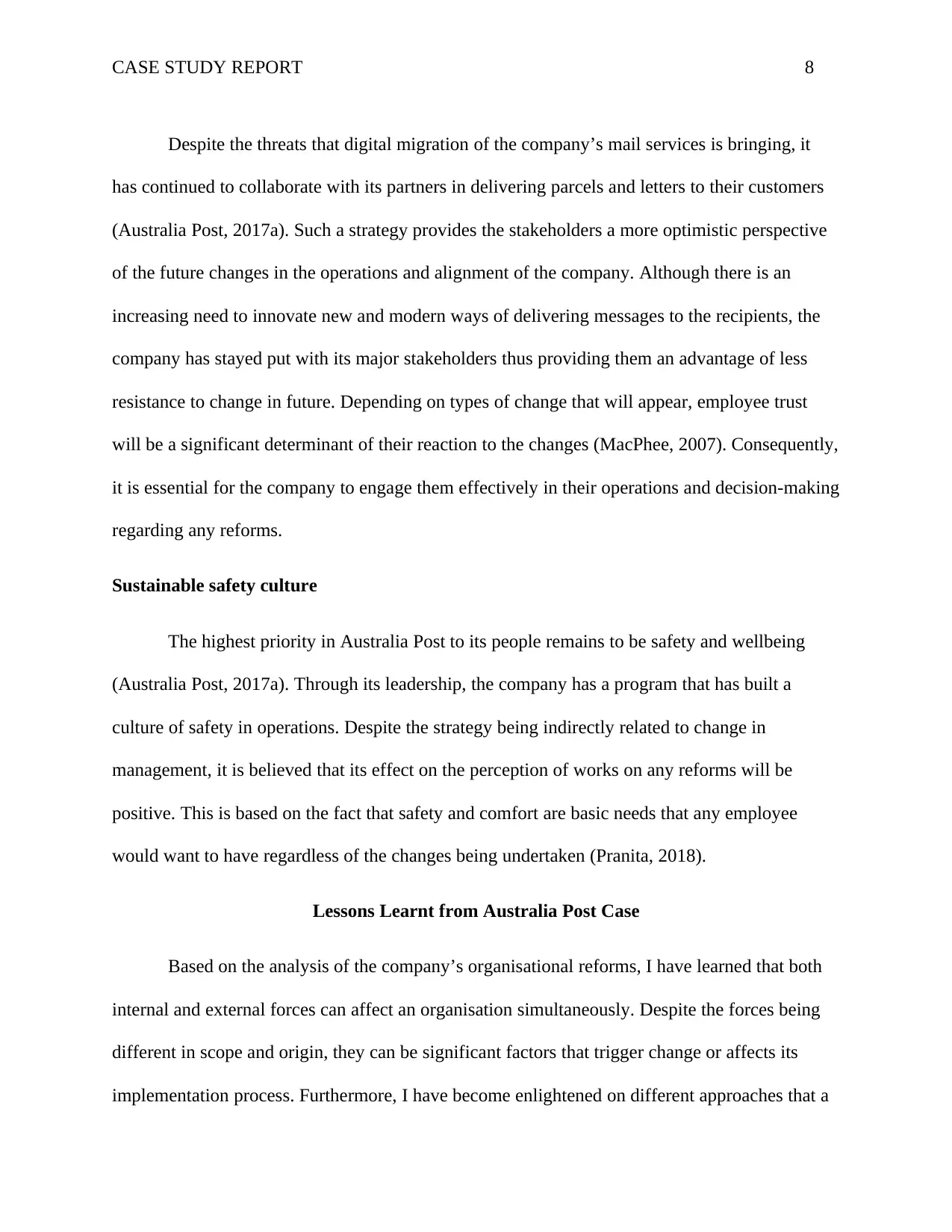
CASE STUDY REPORT 8
Despite the threats that digital migration of the company’s mail services is bringing, it
has continued to collaborate with its partners in delivering parcels and letters to their customers
(Australia Post, 2017a). Such a strategy provides the stakeholders a more optimistic perspective
of the future changes in the operations and alignment of the company. Although there is an
increasing need to innovate new and modern ways of delivering messages to the recipients, the
company has stayed put with its major stakeholders thus providing them an advantage of less
resistance to change in future. Depending on types of change that will appear, employee trust
will be a significant determinant of their reaction to the changes (MacPhee, 2007). Consequently,
it is essential for the company to engage them effectively in their operations and decision-making
regarding any reforms.
Sustainable safety culture
The highest priority in Australia Post to its people remains to be safety and wellbeing
(Australia Post, 2017a). Through its leadership, the company has a program that has built a
culture of safety in operations. Despite the strategy being indirectly related to change in
management, it is believed that its effect on the perception of works on any reforms will be
positive. This is based on the fact that safety and comfort are basic needs that any employee
would want to have regardless of the changes being undertaken (Pranita, 2018).
Lessons Learnt from Australia Post Case
Based on the analysis of the company’s organisational reforms, I have learned that both
internal and external forces can affect an organisation simultaneously. Despite the forces being
different in scope and origin, they can be significant factors that trigger change or affects its
implementation process. Furthermore, I have become enlightened on different approaches that a
Despite the threats that digital migration of the company’s mail services is bringing, it
has continued to collaborate with its partners in delivering parcels and letters to their customers
(Australia Post, 2017a). Such a strategy provides the stakeholders a more optimistic perspective
of the future changes in the operations and alignment of the company. Although there is an
increasing need to innovate new and modern ways of delivering messages to the recipients, the
company has stayed put with its major stakeholders thus providing them an advantage of less
resistance to change in future. Depending on types of change that will appear, employee trust
will be a significant determinant of their reaction to the changes (MacPhee, 2007). Consequently,
it is essential for the company to engage them effectively in their operations and decision-making
regarding any reforms.
Sustainable safety culture
The highest priority in Australia Post to its people remains to be safety and wellbeing
(Australia Post, 2017a). Through its leadership, the company has a program that has built a
culture of safety in operations. Despite the strategy being indirectly related to change in
management, it is believed that its effect on the perception of works on any reforms will be
positive. This is based on the fact that safety and comfort are basic needs that any employee
would want to have regardless of the changes being undertaken (Pranita, 2018).
Lessons Learnt from Australia Post Case
Based on the analysis of the company’s organisational reforms, I have learned that both
internal and external forces can affect an organisation simultaneously. Despite the forces being
different in scope and origin, they can be significant factors that trigger change or affects its
implementation process. Furthermore, I have become enlightened on different approaches that a
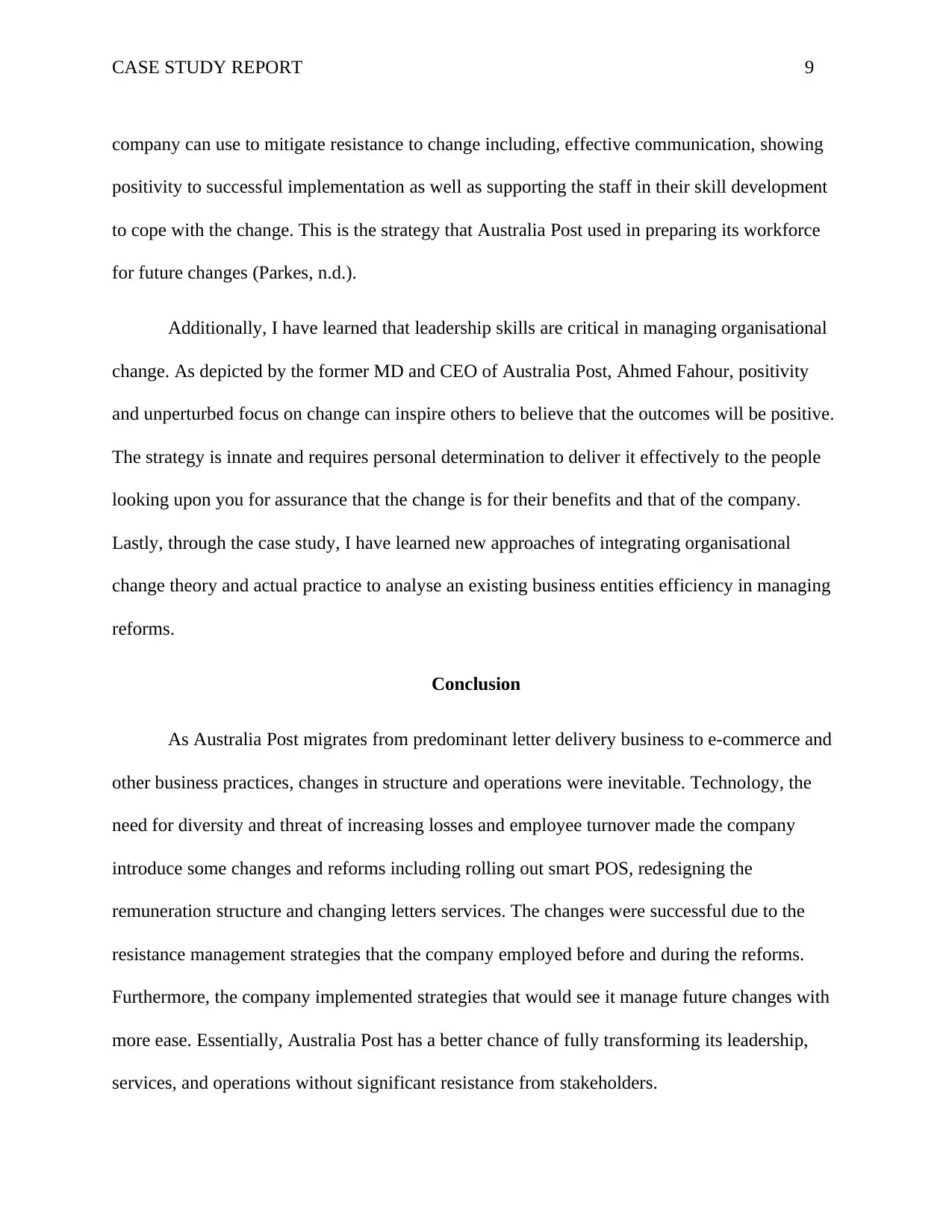
CASE STUDY REPORT 9
company can use to mitigate resistance to change including, effective communication, showing
positivity to successful implementation as well as supporting the staff in their skill development
to cope with the change. This is the strategy that Australia Post used in preparing its workforce
for future changes (Parkes, n.d.).
Additionally, I have learned that leadership skills are critical in managing organisational
change. As depicted by the former MD and CEO of Australia Post, Ahmed Fahour, positivity
and unperturbed focus on change can inspire others to believe that the outcomes will be positive.
The strategy is innate and requires personal determination to deliver it effectively to the people
looking upon you for assurance that the change is for their benefits and that of the company.
Lastly, through the case study, I have learned new approaches of integrating organisational
change theory and actual practice to analyse an existing business entities efficiency in managing
reforms.
Conclusion
As Australia Post migrates from predominant letter delivery business to e-commerce and
other business practices, changes in structure and operations were inevitable. Technology, the
need for diversity and threat of increasing losses and employee turnover made the company
introduce some changes and reforms including rolling out smart POS, redesigning the
remuneration structure and changing letters services. The changes were successful due to the
resistance management strategies that the company employed before and during the reforms.
Furthermore, the company implemented strategies that would see it manage future changes with
more ease. Essentially, Australia Post has a better chance of fully transforming its leadership,
services, and operations without significant resistance from stakeholders.
company can use to mitigate resistance to change including, effective communication, showing
positivity to successful implementation as well as supporting the staff in their skill development
to cope with the change. This is the strategy that Australia Post used in preparing its workforce
for future changes (Parkes, n.d.).
Additionally, I have learned that leadership skills are critical in managing organisational
change. As depicted by the former MD and CEO of Australia Post, Ahmed Fahour, positivity
and unperturbed focus on change can inspire others to believe that the outcomes will be positive.
The strategy is innate and requires personal determination to deliver it effectively to the people
looking upon you for assurance that the change is for their benefits and that of the company.
Lastly, through the case study, I have learned new approaches of integrating organisational
change theory and actual practice to analyse an existing business entities efficiency in managing
reforms.
Conclusion
As Australia Post migrates from predominant letter delivery business to e-commerce and
other business practices, changes in structure and operations were inevitable. Technology, the
need for diversity and threat of increasing losses and employee turnover made the company
introduce some changes and reforms including rolling out smart POS, redesigning the
remuneration structure and changing letters services. The changes were successful due to the
resistance management strategies that the company employed before and during the reforms.
Furthermore, the company implemented strategies that would see it manage future changes with
more ease. Essentially, Australia Post has a better chance of fully transforming its leadership,
services, and operations without significant resistance from stakeholders.
⊘ This is a preview!⊘
Do you want full access?
Subscribe today to unlock all pages.

Trusted by 1+ million students worldwide
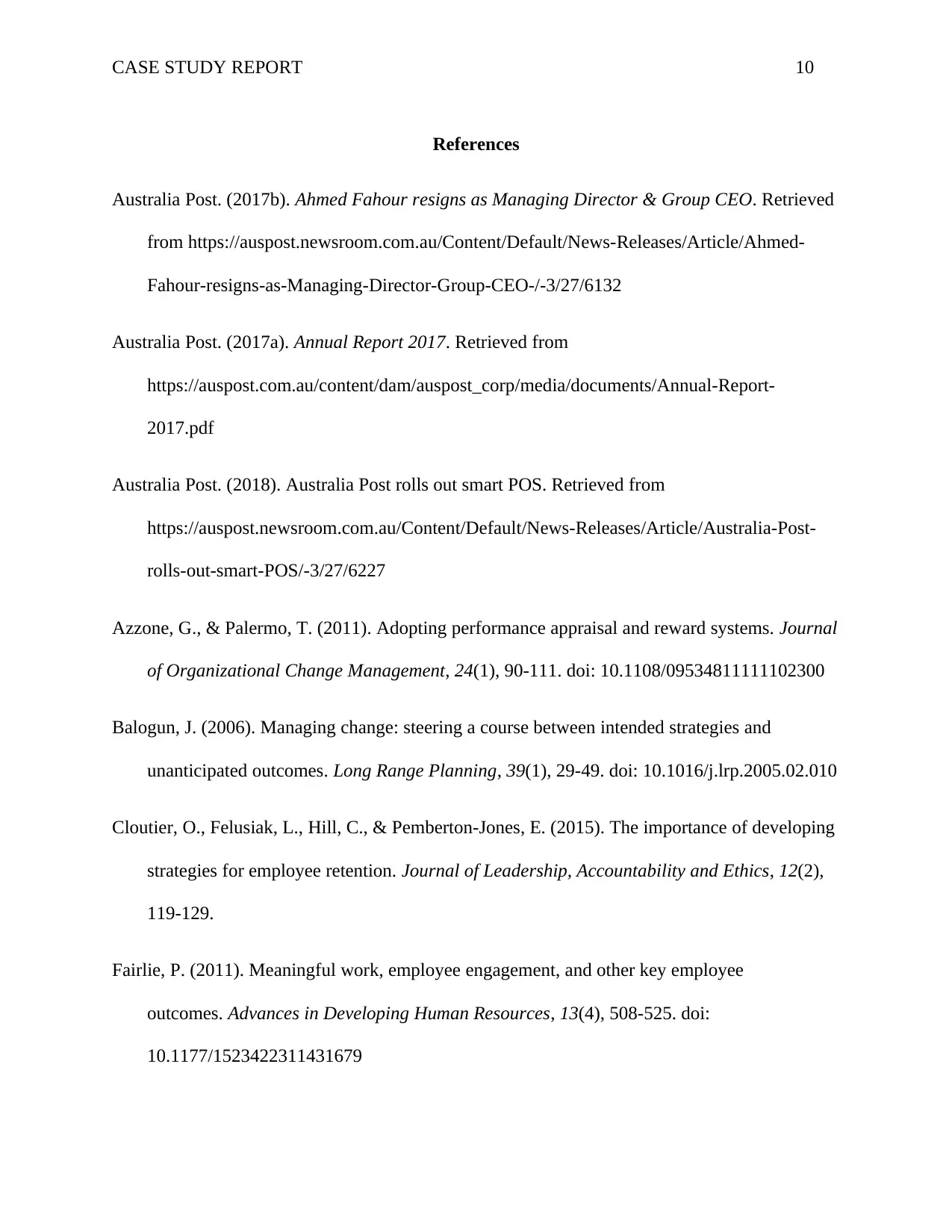
CASE STUDY REPORT 10
References
Australia Post. (2017b). Ahmed Fahour resigns as Managing Director & Group CEO. Retrieved
from https://auspost.newsroom.com.au/Content/Default/News-Releases/Article/Ahmed-
Fahour-resigns-as-Managing-Director-Group-CEO-/-3/27/6132
Australia Post. (2017a). Annual Report 2017. Retrieved from
https://auspost.com.au/content/dam/auspost_corp/media/documents/Annual-Report-
2017.pdf
Australia Post. (2018). Australia Post rolls out smart POS. Retrieved from
https://auspost.newsroom.com.au/Content/Default/News-Releases/Article/Australia-Post-
rolls-out-smart-POS/-3/27/6227
Azzone, G., & Palermo, T. (2011). Adopting performance appraisal and reward systems. Journal
of Organizational Change Management, 24(1), 90-111. doi: 10.1108/09534811111102300
Balogun, J. (2006). Managing change: steering a course between intended strategies and
unanticipated outcomes. Long Range Planning, 39(1), 29-49. doi: 10.1016/j.lrp.2005.02.010
Cloutier, O., Felusiak, L., Hill, C., & Pemberton-Jones, E. (2015). The importance of developing
strategies for employee retention. Journal of Leadership, Accountability and Ethics, 12(2),
119-129.
Fairlie, P. (2011). Meaningful work, employee engagement, and other key employee
outcomes. Advances in Developing Human Resources, 13(4), 508-525. doi:
10.1177/1523422311431679
References
Australia Post. (2017b). Ahmed Fahour resigns as Managing Director & Group CEO. Retrieved
from https://auspost.newsroom.com.au/Content/Default/News-Releases/Article/Ahmed-
Fahour-resigns-as-Managing-Director-Group-CEO-/-3/27/6132
Australia Post. (2017a). Annual Report 2017. Retrieved from
https://auspost.com.au/content/dam/auspost_corp/media/documents/Annual-Report-
2017.pdf
Australia Post. (2018). Australia Post rolls out smart POS. Retrieved from
https://auspost.newsroom.com.au/Content/Default/News-Releases/Article/Australia-Post-
rolls-out-smart-POS/-3/27/6227
Azzone, G., & Palermo, T. (2011). Adopting performance appraisal and reward systems. Journal
of Organizational Change Management, 24(1), 90-111. doi: 10.1108/09534811111102300
Balogun, J. (2006). Managing change: steering a course between intended strategies and
unanticipated outcomes. Long Range Planning, 39(1), 29-49. doi: 10.1016/j.lrp.2005.02.010
Cloutier, O., Felusiak, L., Hill, C., & Pemberton-Jones, E. (2015). The importance of developing
strategies for employee retention. Journal of Leadership, Accountability and Ethics, 12(2),
119-129.
Fairlie, P. (2011). Meaningful work, employee engagement, and other key employee
outcomes. Advances in Developing Human Resources, 13(4), 508-525. doi:
10.1177/1523422311431679
Paraphrase This Document
Need a fresh take? Get an instant paraphrase of this document with our AI Paraphraser
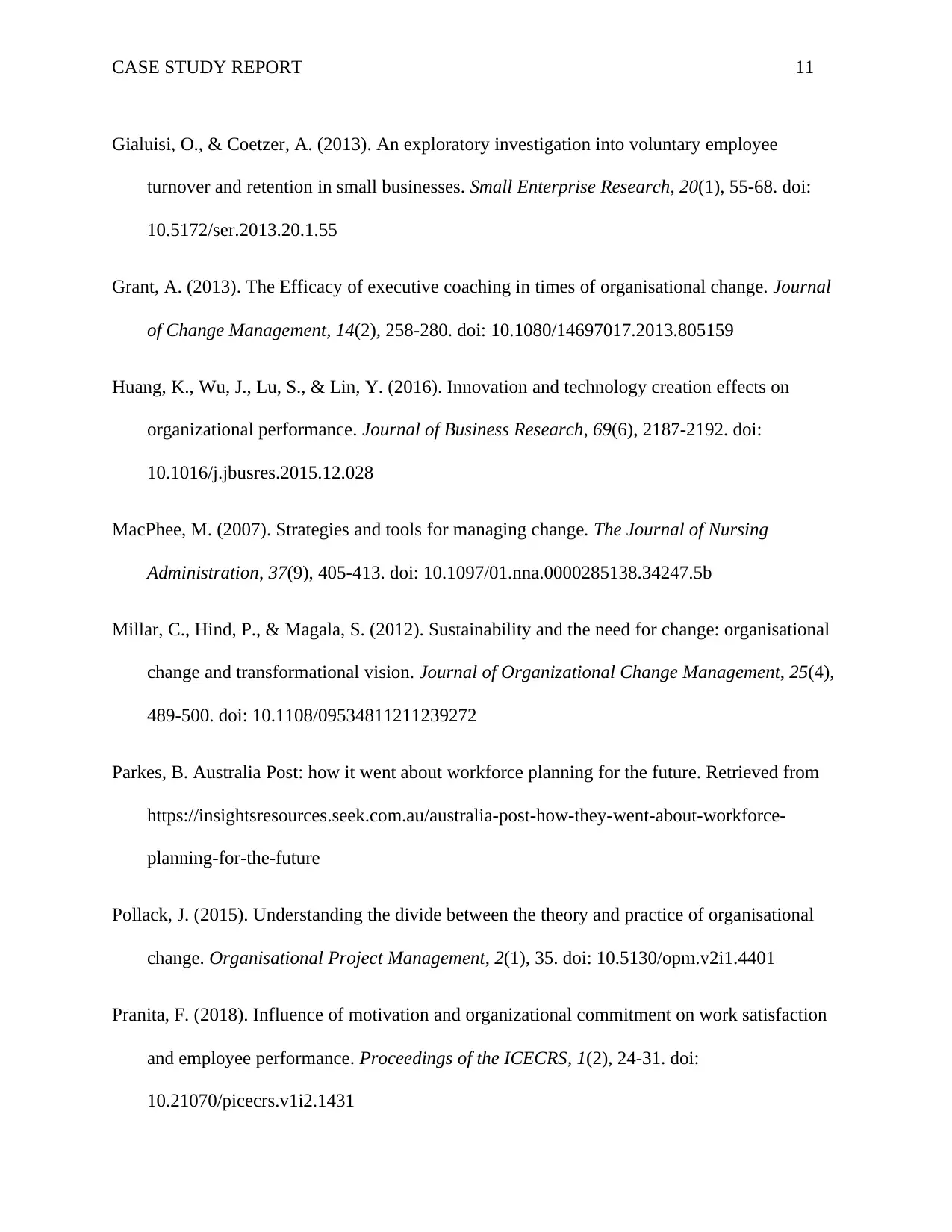
CASE STUDY REPORT 11
Gialuisi, O., & Coetzer, A. (2013). An exploratory investigation into voluntary employee
turnover and retention in small businesses. Small Enterprise Research, 20(1), 55-68. doi:
10.5172/ser.2013.20.1.55
Grant, A. (2013). The Efficacy of executive coaching in times of organisational change. Journal
of Change Management, 14(2), 258-280. doi: 10.1080/14697017.2013.805159
Huang, K., Wu, J., Lu, S., & Lin, Y. (2016). Innovation and technology creation effects on
organizational performance. Journal of Business Research, 69(6), 2187-2192. doi:
10.1016/j.jbusres.2015.12.028
MacPhee, M. (2007). Strategies and tools for managing change. The Journal of Nursing
Administration, 37(9), 405-413. doi: 10.1097/01.nna.0000285138.34247.5b
Millar, C., Hind, P., & Magala, S. (2012). Sustainability and the need for change: organisational
change and transformational vision. Journal of Organizational Change Management, 25(4),
489-500. doi: 10.1108/09534811211239272
Parkes, B. Australia Post: how it went about workforce planning for the future. Retrieved from
https://insightsresources.seek.com.au/australia-post-how-they-went-about-workforce-
planning-for-the-future
Pollack, J. (2015). Understanding the divide between the theory and practice of organisational
change. Organisational Project Management, 2(1), 35. doi: 10.5130/opm.v2i1.4401
Pranita, F. (2018). Influence of motivation and organizational commitment on work satisfaction
and employee performance. Proceedings of the ICECRS, 1(2), 24-31. doi:
10.21070/picecrs.v1i2.1431
Gialuisi, O., & Coetzer, A. (2013). An exploratory investigation into voluntary employee
turnover and retention in small businesses. Small Enterprise Research, 20(1), 55-68. doi:
10.5172/ser.2013.20.1.55
Grant, A. (2013). The Efficacy of executive coaching in times of organisational change. Journal
of Change Management, 14(2), 258-280. doi: 10.1080/14697017.2013.805159
Huang, K., Wu, J., Lu, S., & Lin, Y. (2016). Innovation and technology creation effects on
organizational performance. Journal of Business Research, 69(6), 2187-2192. doi:
10.1016/j.jbusres.2015.12.028
MacPhee, M. (2007). Strategies and tools for managing change. The Journal of Nursing
Administration, 37(9), 405-413. doi: 10.1097/01.nna.0000285138.34247.5b
Millar, C., Hind, P., & Magala, S. (2012). Sustainability and the need for change: organisational
change and transformational vision. Journal of Organizational Change Management, 25(4),
489-500. doi: 10.1108/09534811211239272
Parkes, B. Australia Post: how it went about workforce planning for the future. Retrieved from
https://insightsresources.seek.com.au/australia-post-how-they-went-about-workforce-
planning-for-the-future
Pollack, J. (2015). Understanding the divide between the theory and practice of organisational
change. Organisational Project Management, 2(1), 35. doi: 10.5130/opm.v2i1.4401
Pranita, F. (2018). Influence of motivation and organizational commitment on work satisfaction
and employee performance. Proceedings of the ICECRS, 1(2), 24-31. doi:
10.21070/picecrs.v1i2.1431
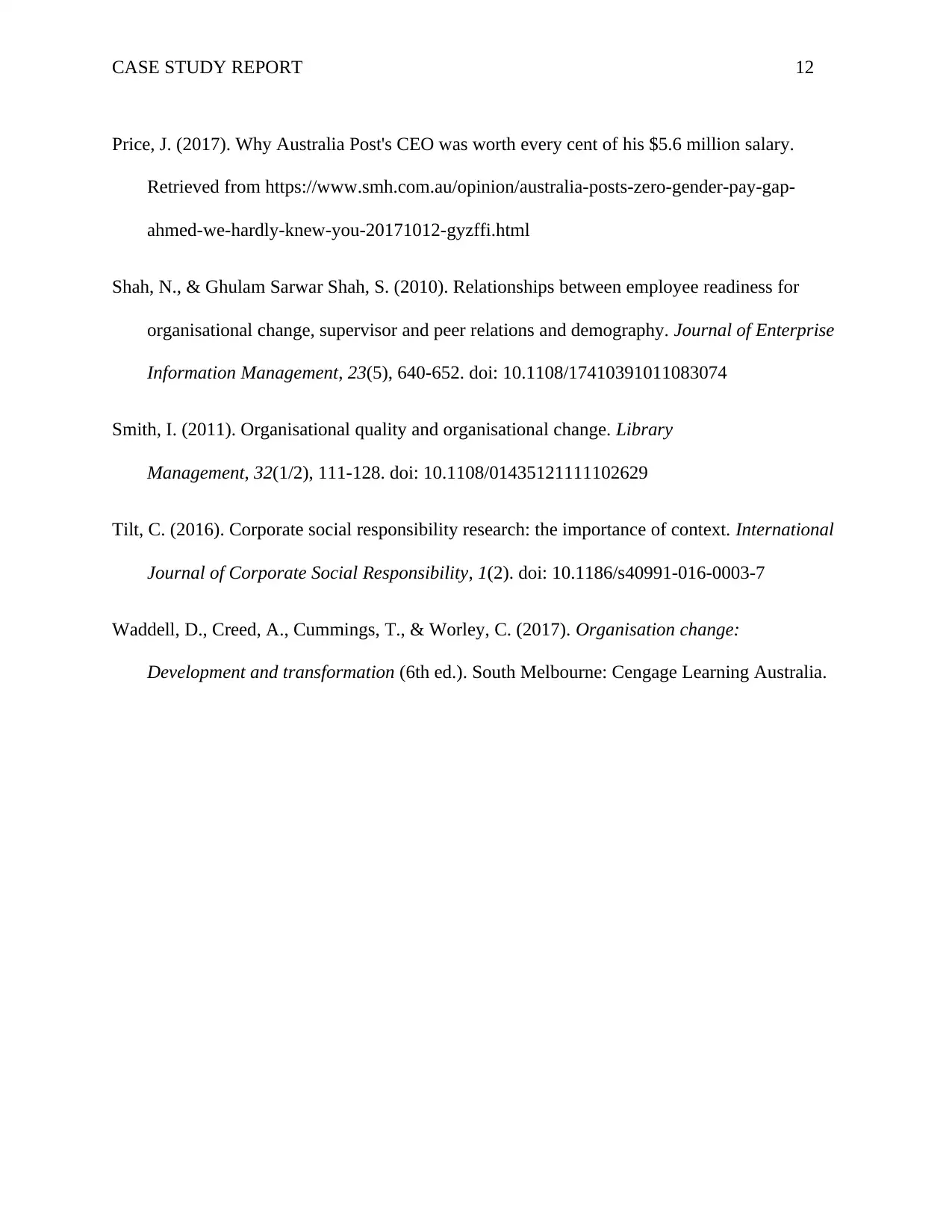
CASE STUDY REPORT 12
Price, J. (2017). Why Australia Post's CEO was worth every cent of his $5.6 million salary.
Retrieved from https://www.smh.com.au/opinion/australia-posts-zero-gender-pay-gap-
ahmed-we-hardly-knew-you-20171012-gyzffi.html
Shah, N., & Ghulam Sarwar Shah, S. (2010). Relationships between employee readiness for
organisational change, supervisor and peer relations and demography. Journal of Enterprise
Information Management, 23(5), 640-652. doi: 10.1108/17410391011083074
Smith, I. (2011). Organisational quality and organisational change. Library
Management, 32(1/2), 111-128. doi: 10.1108/01435121111102629
Tilt, C. (2016). Corporate social responsibility research: the importance of context. International
Journal of Corporate Social Responsibility, 1(2). doi: 10.1186/s40991-016-0003-7
Waddell, D., Creed, A., Cummings, T., & Worley, C. (2017). Organisation change:
Development and transformation (6th ed.). South Melbourne: Cengage Learning Australia.
Price, J. (2017). Why Australia Post's CEO was worth every cent of his $5.6 million salary.
Retrieved from https://www.smh.com.au/opinion/australia-posts-zero-gender-pay-gap-
ahmed-we-hardly-knew-you-20171012-gyzffi.html
Shah, N., & Ghulam Sarwar Shah, S. (2010). Relationships between employee readiness for
organisational change, supervisor and peer relations and demography. Journal of Enterprise
Information Management, 23(5), 640-652. doi: 10.1108/17410391011083074
Smith, I. (2011). Organisational quality and organisational change. Library
Management, 32(1/2), 111-128. doi: 10.1108/01435121111102629
Tilt, C. (2016). Corporate social responsibility research: the importance of context. International
Journal of Corporate Social Responsibility, 1(2). doi: 10.1186/s40991-016-0003-7
Waddell, D., Creed, A., Cummings, T., & Worley, C. (2017). Organisation change:
Development and transformation (6th ed.). South Melbourne: Cengage Learning Australia.
⊘ This is a preview!⊘
Do you want full access?
Subscribe today to unlock all pages.

Trusted by 1+ million students worldwide
1 out of 12
Your All-in-One AI-Powered Toolkit for Academic Success.
+13062052269
info@desklib.com
Available 24*7 on WhatsApp / Email
![[object Object]](/_next/static/media/star-bottom.7253800d.svg)
Unlock your academic potential
Copyright © 2020–2025 A2Z Services. All Rights Reserved. Developed and managed by ZUCOL.